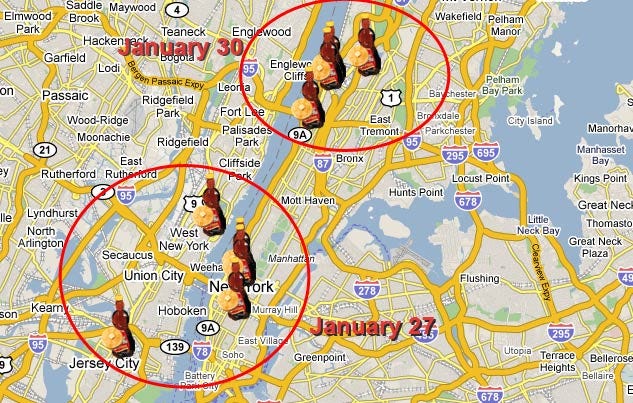A Mysterious Maple Syrup Smell
On how citizens and city officials solved one of New York City's stinkiest mysteries
On October 27th, 2005, something strange happened in New York City: A maple syrup smell wafted over the city. One blogger wrote that the city smelled “delicious, very sweet, and familiar.” Another speculated that maybe “a pancake truck or maple syrup factory has caught on fire.”
In response to the smell, people reported strong cravings to eat sweets — from pumpkin pie to vanilla ice cream. Greg Nickson told The New York Times the aroma transported him to his childhood neighborhood, which was filled with sweet smells from a nearby chocolate factory.
The Times reported the cloud “poured in from across Manhattan after 9 p.m. [on October 27th, and] some feared that it was something sinister.”
The maple syrup smell engulfed the city only a few years after the September 11th terrorist attacks. New Yorkers were on high alert around terrorist threats, so as sweet as the smell was, New Yorkers were paranoid about the mysterious odor.
Calls flooded New York City’s 311 information line. There were so many calls that the city’s Office of Emergency Management investigated the issue in coordination with the Police Department, the Fire Department, the Coast Guard, and the Department of Environmental Protection.
But air quality tests turned up nothing. The city officials determined the smell wasn’t hazardous, but they couldn’t figure out what it was. The New York Police Commissioner, Raymond W. Kelly, noted:
It’s believed to be some sort of food substance, but we can't substantiate that at this time.
The mystery remained: Where was the mysterious maple syrup smell coming from?
The smell returned to the city two months later in December. And it didn’t go away. There were reports of the smell in January 2006, March 2006, and November 2006. A commenter at The Gothamist wrote:
I don’t want to be dramatic, but it’s NYC for chrissakes! The country’s at war, we’ve been attacked, and a frigging syrup smell blankets the city, and no one figures out why. I just don’t get it. Why aren’t city, state, and federal officials addressing this!?
The city still couldn’t figure where the smell was coming from. And, in November 2007, the smell was such a part of the New York consciousness that it made an appearance on the NBC sitcom 30 Rock:
The smell returned again in May 2008. And then in January 2009 — on three separate occasions: January 5th, January 27th, and January 29th-30th.
This time, behind the scenes, city officials were ready. In the past, officials would dispatch air testers to collect samples only after dozens of calls came into 311, and by the time the testers arrived at reported smell locations, the odor had dissipated.
But, in 2009, they tried something new: The air quality investigators were dispatched after only a handful of calls. So, when calls trickled in about the smell from the Upper West Side, four air testers promptly captured samples. The team also gathered atmospheric data like temperature, humidity, and wind direction from past syrup events.
The samples were sent to the Department of Environmental Protection’s laboratory, where the chemical source of the smell was isolated. Simultaneously, the incidents were plotted on a map (seen below), along with atmospheric conditions, to help identify the potential source:
Using this data, officials noted that (1) most complaints came from the Upper West Side and Morningside Heights, (2) winds were moving west to east, and (3) winds were moving fast enough to move the smell across the river but slow enough to now disperse them. Then, the officials assembled a list of odiferous factories in the source vicinity, and working with New Jersey environmental officials, they narrowed the list to one.
So, on February 5th, 2009, New York City Michael Bloomberg held a press conference. The city cracked the case: “I think it’s safe to say that the mystery of the maple syrup mist has been solved,” Bloomberg announced.
The source of the stink: The Frutarom factory in New Jersey, which had been processing fenugreek seeds.
Specifically, Frutarom was extracting the chemical sotolon from fenugreek — a chemical used as a food flavoring agent to create a sweet caramelized flavor, like what you’d taste in molasses or (you guessed it) maple syrup. The molecule is heavy and evaporates slowly, which is why it could linger over New York City. And, it’s potent: People can taste it at concentrations of just 0.02 parts per million, which is 2,000 times more potent than vanillin (the main component of vanilla flavor). That’s why so many New Yorkers could smell it around the city.
The Emergency Management Commissioner Joseph Bruno said: “Thanks to good information sharing among City agencies and cooperation with our partners in New Jersey, we were able to develop detailed maps that showed a clear pattern and helped us zero in on the odor’s source, but we couldn’t have solved the mystery without help from vigilant New Yorkers whose noses provided the data we needed to crack the case.”
A little sniffing, a little collecting, and a lot of collaborating: The best way to solve a mystery.








